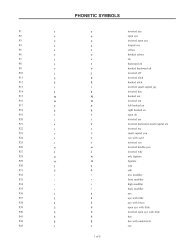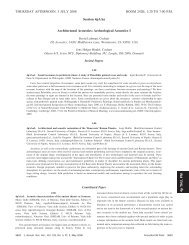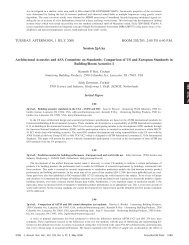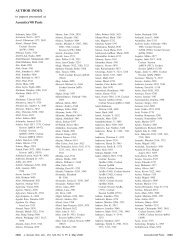Tuesday afternoon, 11 November - The Acoustical Society of America
Tuesday afternoon, 11 November - The Acoustical Society of America
Tuesday afternoon, 11 November - The Acoustical Society of America
You also want an ePaper? Increase the reach of your titles
YUMPU automatically turns print PDFs into web optimized ePapers that Google loves.
TUESDAY AFTERNOON, <strong>11</strong> NOVEMBER 2008 LEGENDS 3, 1:30 TO 4:00 P.M.<br />
Session 2pEA<br />
Engineering Acoustics: Acoustic Engineering <strong>of</strong> Materials and Techniques<br />
1:30<br />
2pEA1. Coupling coefficient <strong>of</strong> segmented stack piezoelectric<br />
transducers using high-coupling materials. Stephen C. Thompson,<br />
Richard J. Meyer, and Douglas C. Markley Appl. Res. Lab., <strong>The</strong> Penn State<br />
Univ., P.O. Box 30, State College, PA 16804<br />
High-power piezoelectric transducers normally use a segmented stack <strong>of</strong><br />
piezoelectric pieces. <strong>The</strong> pieces are arranged with alternating polarization<br />
and are driven by electrodes <strong>of</strong> alternating voltage polarity. This allows long<br />
stacks to be built from easily manufactured pieces and reduces the voltage<br />
required for full power operation. <strong>The</strong> common understanding among transducer<br />
designers is that the mechanical properties <strong>of</strong> the stack <strong>of</strong> n pieces are<br />
equivalent to those <strong>of</strong> a single piezoelectric piece <strong>of</strong> equal total length, while<br />
the electrical impedance is reduced by the factor n 2 . For conventional designs<br />
with operating bandwidth less than a half octave, this is quite accurate.<br />
However, as new materials with high-electromechanical coupling make it<br />
possible to design high-power transducers with bandwidths greater than an<br />
octave, the use <strong>of</strong> segmented stacks must be reexamined. With high coupling<br />
materials, there is a significant reduction in effective coupling coefficient<br />
caused by stack segmentation. <strong>The</strong> effect is small for materials such as hard<br />
PZT, but is larger in at least some transducers built from materials with coupling<br />
coefficient above 80%. This paper will address the effects <strong>of</strong> stack design<br />
based on modeled and measured results. Work supported by the Office<br />
<strong>of</strong> Naval Research.<br />
1:45<br />
2pEA2. Galfenol material properties and impact on transducer design.<br />
Ryan S. Scott Knowles Electronics, LLC, <strong>11</strong>51 Maplewood Dr., Itasca, IL<br />
60143, Richard J. Meyer, Jr., and Stephen C. Thompson <strong>The</strong> Penn State<br />
Univ., State College, PA 16804<br />
A simple measurement technique to accurately characterize magnetostrictive<br />
materials such as Terfenol-D and Galfenol is required as they become<br />
more widely used. A technique was developed that measures the mag-<br />
T H<br />
netostrictive d33 , µ 33 , s22 , and Qm constants using a pair <strong>of</strong> Helmholtz<br />
coils, a laser vibrometer, and a sense coil. Unlike previous methods, this<br />
technique does not require that the magnetostrictive sample be built into a<br />
transducerlike apparatus. A matrix <strong>of</strong> magnetostrictive material properties as<br />
a function <strong>of</strong> magnetic bias and ac drive amplitude can be created using the<br />
developed method. To demonstrate the usefulness <strong>of</strong> this technique, stress<br />
annealed laminated Fe–18.4%Ga rods were tested. Property trends observed<br />
for these samples will be reported as well as their impact on transducer<br />
performance. This work was sponsored by the Office <strong>of</strong> Naval Research<br />
Contract No. N00014-06-1-0530 and by Etrema Products, Inc.<br />
2:00<br />
2pEA3. Verification <strong>of</strong> a method for measuring magnetostrictive<br />
parameters for use in transducer design modeling. Scott Porter, Ryan<br />
Scott, Richard Meyer, Jr., and Stephen Thompson Appl. Res. Lab., <strong>The</strong><br />
Penn State Univ., State College, PA 16804, scott.porter@psu.edu<br />
Previous studies have initiated an investigation into a new method <strong>of</strong><br />
T H<br />
measuring the d33 , µ 33 , and s33 magnetostrictive constants <strong>of</strong> a given<br />
Thomas R. Howarth, Cochair<br />
NAVSEA Newport, <strong>11</strong>76 Howell St., Newport, RI 02841<br />
Kim C. Benjamin, Cochair<br />
NAVSEA Newport, Newport, RI 02841<br />
Contributed Papers<br />
sample using a pair <strong>of</strong> Helmholtz coils, a laser vibrometer, and a sense coil.<br />
<strong>The</strong>se parameters are calculated from measurements made as a function <strong>of</strong><br />
dc magnetic bias and ac drive amplitude. This method contrasts with the traditional<br />
measurement technique which involves building the sample into a<br />
transducerlike device. <strong>The</strong> new method was demonstrated for laminated<br />
stress-annealed Galfenol rods <strong>of</strong> high aspect ratio. Measurements obtained<br />
by this method appear credible and demonstrate good repeatability. For verification,<br />
the authors have returned to the established approach and designed<br />
a simple transducer using one <strong>of</strong> the measured Galfenol rods. <strong>The</strong> transducer<br />
was driven in air as a function <strong>of</strong> dc magnetic bias and ac drive amplitude.<br />
Data obtained from this transducer are compared to an analytical model that<br />
uses the material properties obtained experimentally with the new method.<br />
This work was sponsored by the Office <strong>of</strong> Naval Research Contract<br />
N00014-06-1-0530 and by Etrema Products, Inc.<br />
2:15<br />
2pEA4. Estimating the mechanical properties <strong>of</strong> acrylic plates via<br />
acoustic transmission experiments and modeling. Natasha A. Chang<br />
Dept. <strong>of</strong> Mech. Eng., Univ. <strong>of</strong> Michigan, 1231 Beal Ave., 2010 Autolab,<br />
Ann Arbor, MI 48109 and David R. Dowling Univ. <strong>of</strong> Michigan, Ann Arbor,<br />
MI 48109<br />
Clear acrylic polymethylmethacrylate PMMA is commonly used to<br />
separate instruments from the test-section flow in water tunnel experiments.<br />
Thus, for some hydroacoustic studies, knowledge <strong>of</strong> the sound transmission<br />
properties <strong>of</strong> acrylic plates may be essential. Unfortunately, the actual mechanical<br />
properties <strong>of</strong> PMMA plates cover a relatively large range e.g., the<br />
elastic modulus can vary from 2 to 5.5 GPa and these mechanical properties<br />
may be frequency dependent. In this presentation, numerical and experimental<br />
results for acoustic pulse transmission through submerged flat PMMA<br />
plates are compared to identify plate properties and to calibrate an approximate<br />
plate transmission model. <strong>The</strong> experiments were conducted in a fish<br />
tank at sound incidence angles <strong>of</strong> 0–35 deg with a spherical wave source and<br />
two receivers. <strong>The</strong> transmitted sounds were short pulses with a nominal frequency<br />
range <strong>of</strong> 40–200 kHz. Several plate thicknesses, d, were tested for kd<br />
values k is the acoustic wave number in the water from 0.25 to 16. A sound<br />
propagation code was used to calculate the transmission characteristics <strong>of</strong><br />
the plate. By minimizing the difference between the calculated and measured<br />
waveforms, the mechanical properties <strong>of</strong> the PMMA plates were<br />
estimated. Work sponsored by ONR.<br />
2:30<br />
2pEA5. Two ultrasonic transducer through-wall communication system<br />
analysis. Henry A. Scarton Dept. <strong>of</strong> Mech., Aerosp., Nuclear Eng., Rensselaer<br />
Polytechnic Inst., Troy, NY 12180<br />
<strong>The</strong> use <strong>of</strong> ultrasound to convey data from one side <strong>of</strong> a metallic wall to<br />
the other side is presented. A communication channel is established by attaching<br />
two ultrasonic crystals to either side <strong>of</strong> the wall. <strong>The</strong> outside transducer<br />
injects a continuous ultrasonic wave into the wall. <strong>The</strong> inside transducer<br />
operates as an energy harvester and signal modulator. <strong>The</strong> outside<br />
transducer also receives the modulated signal reflected back from the wall<br />
containing the inside transducer. A sensor on the inside provides analog data<br />
2487 J. Acoust. Soc. Am., Vol. 124, No. 4, Pt. 2, October 2008 156th Meeting: <strong>Acoustical</strong> <strong>Society</strong> <strong>of</strong> <strong>America</strong><br />
2487<br />
2p TUE. PM







